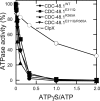Positive cooperativity of the p97 AAA ATPase is critical for essential functions
- PMID: 21454554
- PMCID: PMC3091191
- DOI: 10.1074/jbc.M110.201400
Positive cooperativity of the p97 AAA ATPase is critical for essential functions
Abstract
p97 is composed of two conserved AAA (ATPases associated with diverse cellular activities) domains, which form a tandem hexameric ring. We characterized the ATP hydrolysis mechanism of CDC-48.1, a p97 homolog of Caenorhabditis elegans. The ATPase activity of the N-terminal AAA domain was very low at physiological temperature, whereas the C-terminal AAA domain showed high ATPase activity in a coordinated fashion with positive cooperativity. The cooperativity and coordination are generated by different mechanisms because a noncooperative mutant still showed the coordination. Interestingly, the growth speed of yeast cells strongly related to the positive cooperativity rather than the ATPase activity itself, suggesting that the positive cooperativity is critical for the essential functions of p97.
Figures







Similar articles
-
TRIP13 is a protein-remodeling AAA+ ATPase that catalyzes MAD2 conformation switching.Elife. 2015 Apr 28;4:e07367. doi: 10.7554/eLife.07367. Elife. 2015. PMID: 25918846 Free PMC article.
-
Structural insights into the unusually strong ATPase activity of the AAA domain of the Caenorhabditis elegans fidgetin-like 1 (FIGL-1) protein.J Biol Chem. 2013 Oct 11;288(41):29305-12. doi: 10.1074/jbc.M113.502559. Epub 2013 Aug 26. J Biol Chem. 2013. PMID: 23979136 Free PMC article.
-
Characterization of C-terminal adaptors, UFD-2 and UFD-3, of CDC-48 on the polyglutamine aggregation in C. elegans.Biochem Biophys Res Commun. 2015 Mar 27;459(1):154-60. doi: 10.1016/j.bbrc.2015.02.088. Epub 2015 Feb 24. Biochem Biophys Res Commun. 2015. PMID: 25721663
-
ATP-bound form of the D1 AAA domain inhibits an essential function of Cdc48p/p97.Biochem Cell Biol. 2010 Feb;88(1):109-17. doi: 10.1139/o09-116. Biochem Cell Biol. 2010. PMID: 20130684 Review.
-
Control of p97 function by cofactor binding.FEBS Lett. 2015 Sep 14;589(19 Pt A):2578-89. doi: 10.1016/j.febslet.2015.08.028. Epub 2015 Aug 29. FEBS Lett. 2015. PMID: 26320413 Review.
Cited by
-
Thermodynamic coupling between neighboring binding sites in homo-oligomeric ligand sensing proteins from mass resolved ligand-dependent population distributions.Protein Sci. 2022 Oct;31(10):e4424. doi: 10.1002/pro.4424. Protein Sci. 2022. PMID: 36173171 Free PMC article.
-
Altered intersubunit communication is the molecular basis for functional defects of pathogenic p97 mutants.J Biol Chem. 2013 Dec 20;288(51):36624-35. doi: 10.1074/jbc.M113.488924. Epub 2013 Nov 6. J Biol Chem. 2013. PMID: 24196964 Free PMC article.
-
Cryo-EM structures of human p97 double hexamer capture potentiated ATPase-competent state.Cell Discov. 2022 Feb 22;8(1):19. doi: 10.1038/s41421-022-00379-1. Cell Discov. 2022. PMID: 35190543 Free PMC article.
-
Elements in nucleotide sensing and hydrolysis of the AAA+ disaggregation machine ClpB: a structure-based mechanistic dissection of a molecular motor.Acta Crystallogr D Biol Crystallogr. 2014 Feb;70(Pt 2):582-95. doi: 10.1107/S1399004713030629. Epub 2014 Jan 31. Acta Crystallogr D Biol Crystallogr. 2014. PMID: 24531492 Free PMC article.
-
Mutations in the Human AAA+ Chaperone p97 and Related Diseases.Front Mol Biosci. 2016 Dec 1;3:79. doi: 10.3389/fmolb.2016.00079. eCollection 2016. Front Mol Biosci. 2016. PMID: 27990419 Free PMC article. Review.
References
-
- Ogura T., Wilkinson A. J. (2001) Genes Cells 6, 575–597 - PubMed
-
- Ammelburg M., Frickey T., Lupas A. N. (2006) J. Struct. Biol. 156, 2–11 - PubMed
-
- Latterich M., Fröhlich K. U., Schekman R. (1995) Cell 82, 885–893 - PubMed
-
- Rabouille C., Levine T. P., Peters J. M., Warren G. (1995) Cell 82, 905–914 - PubMed
-
- Patel S. K., Indig F. E., Olivieri N., Levine N. D., Latterich M. (1998) Cell 92, 611–620 - PubMed
Publication types
MeSH terms
Substances
LinkOut - more resources
Full Text Sources
Molecular Biology Databases

